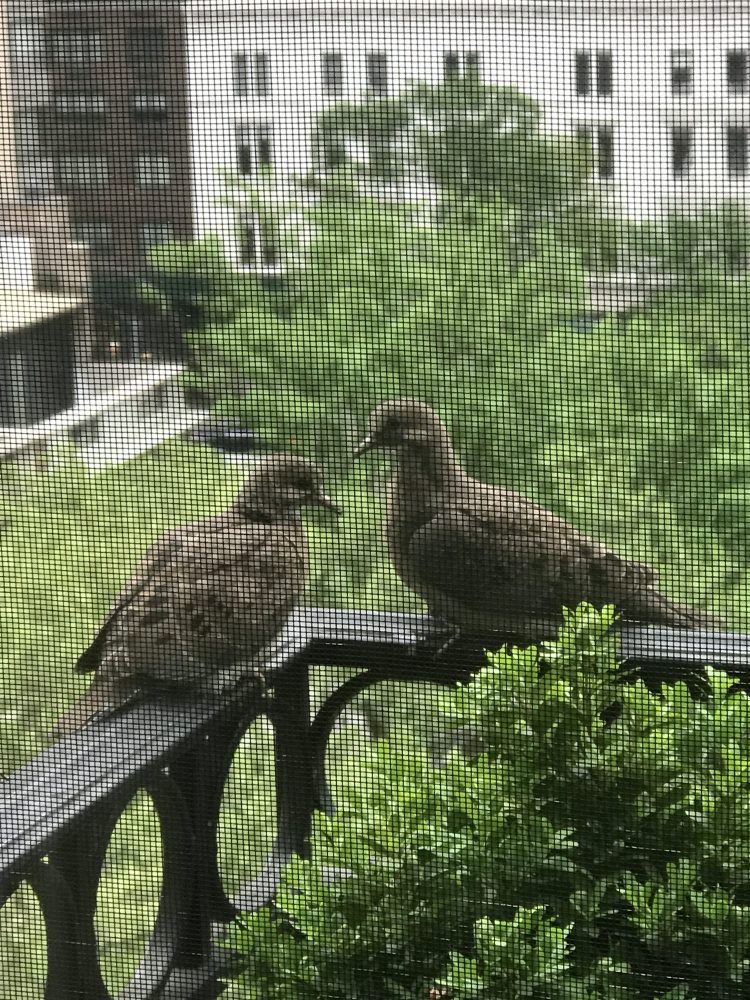If you wish the profound, generous, encompassing things, New York is your natural center of gravity Walt Whitman insisted, and you’ll get no contrary argument from me. How often I’ve written of my love for New York as a stimulant for daily living and writing! The sounds and sights, to say nothing of the energies and rhythms, all combine to create a magical brew. And the stories spinning through the air around one serve up an artistic stimulus more intoxicating than any elixir intended to thrill the senses. But there are sometimes surprises coming from other directions. My private life with nature has always been one of those.
Families of mourning doves set up nests and live full reproductive evolution in my city window boxes every year, from spring to fall. They have eight iterations of the amazing process through the season, meaning sixteen new mourning doves, if all survive. Beethoven reminded us that nature is a glorious school for the heart!…and so it is. As strangely incongruous as these little families are in their New York City habitat, I always feel I’ve learned something new about parenting from them, even after a decade of welcoming them back to my apartment windows. The uniqueness of getting up so close to a natural phenomenon in a city many would expect to be about as far away from nature as a concrete jungle can get, is part of what makes this city so invigorating.
You might well wonder how much more I can learn from these parents and their homely little children after so many years, but I’m never disappointed. I always feel the tingle of excitement one gets from learning new things directly from the source. This year, my first cycle of Doves came at a propitious time for my writing, as I’d just reached a stage in my latest historical novel needing a shot of expertise concerning the ideal parenting techniques collected through our social history. Watching the continuous, shared care delivered by both mother and father dove, and the way they move from full to part-time attendance, until finally the babies decide on their own that they’re ready to fledge, reminds me of another unusually successful method of parenting inaugurated by the Dutch during the 1600s, and that in turn sparked an inspiration to use the doves to round out the portrait of my young protagonist’s family life with her children in my sequel to Certain Liberties. I’m now filling my days and nights with concentrated attention to editing The Gilded Cage, and the seventeenth-century Dutch version of home and family, so different from the rest of Europe and America, plays a central role.
Unlike sophisticated societies elsewhere, Dutch mothers raised their own children without nurses, as they were inclined to live without servants and to encourage children to become independent individuals, using formal education outside the home in schools as early as the age of three, and continuing to teach at home, as well. The child was the center of the home-life and the home the center of family life. In the Netherlands, this happened a century before it happened elsewhere, and that fact is extremely useful in explaining the way the children in The Gilded Cage interact with their mother.
I think we all know there seems to be a difference in the communication skills of a very young child who’s continuously engaged by parents in conversation and critical thinking. Parents who feel their own happiness depends on their skill at child rearing and the happiness of their offspring remind me of the mourning doves. And those inner-city nests mirror the early homes in the Netherlands. Lucky I am, to have such a close personal tie to the natural world right in my city window, and blessed to have the continuous vision of what my protagonist was emulating when she reared her children. Knowing her as I do now, I’ll bet this nineteenth-century violinist, Emily Alden, agreed with Beethoven that connecting the heart to the natural world was the best way to live, and that means for her young doves, too.


Thanks for zooming in on a part of the city environment I often forget exists. And the window on parenting examples, which a city like New York, gives one many opportunities to witness differences among parents of diverse backgrounds. And now you have included a pair I never thought of.
It got me to thinking…I wonder if the doves learn something from being full fledged citizens and observers in our metropolis?
You hit it! We’re all citizens of this amazing city, and that includes creatures great and small. Truly, it reminds me of the way New Amsterdam blossomed in the 1600s! So, either I’ve been living with my characters too long or I’ve finally understood the true reality of evolution. Thanks for pointing out the importance of recognizing the beauty of all our amazing citizens, Paul.